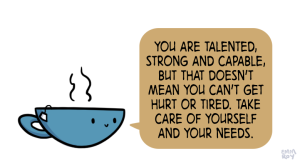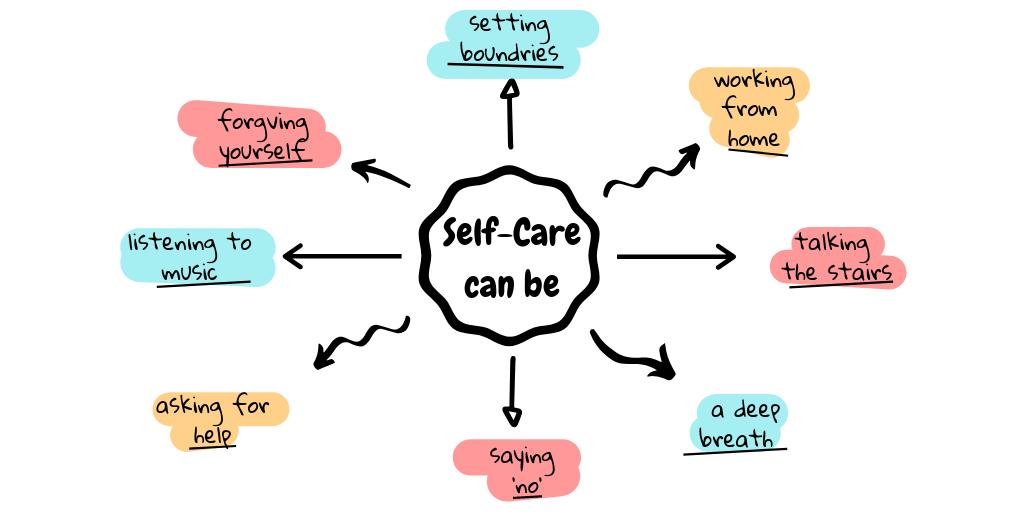With all of the stressors and events happening in this modern time, it’s imperative that we show ourselves some compassion and self-care, if nothing else, to keep a little semblance of sanity and peace! It’s easy to get caught up in the factors that bring us stress in our lives and the workplace. We have discovered that Practicing and promoting self-care and wellness in the workplace often leads to strengthened morale, better productivity, decreased stress, and more motivation. These are some great and simple ways you and your company can improve on your general wellbeing in the workplace, which can make a big difference during stressful times like these.
Meditate in-between Major Tasks
All breaks for our brains are valuable, but taking the time to meditate, even if it’s just for a couple of minutes, can really improve your emotional well-being. There are some great apps for meditation like Insight Timer, Calm, and Headspace that can help you clear your mind and regain some peace when you need to.
Detox From Social Media
Social media isn’t all bad, but an estimated 210 million people are addicted worldwide, and teens who use it frequently are demonstrably more likely to display depression, especially if they’re female. Consider a detox to remind your brain what’s really important and escape the dopamine abuse cycle that leads to social media dependence.
Get a Massage
No matter what industry you work in, massages help you ease whatever physical tension you might be holding onto. If you have a more rigorous job, then they help you take care of your body as well. Relax those muscles.
Invest in a Standing Desk or Pad
While sitting might not be the new smoking, doing so for more than 8 hours can increase your risk of chronic disease by 10 to 20 percent. Try out an adjustable standing desk to mitigate the negative impact of excessive sitting and stay awake through the afternoon slump. In jobs where you stand all day, ask your employer for a pad to place beneath your feet.

Take Exercise Breaks
Exercise not only helps to facilitate better health, but it is proven to help emotionally and mentally, thanks to the release of endorphins. Try walking around the office or the block for 10 minutes when you feel overwhelmed or tired to improve mood and focus.
Take Breaks in General
One simple 5 to 10-minute break every 90 minutes can help your brain rest and rejuvenate, which provides significant focus benefits. Use that time to do something that distracts you from your job. Listen to music, call your grandma, whatever.
Keep Healthy Snacks Nearby
Grazing throughout the day is crucial to keeping your energy up. A proper balance of healthy fats, carbs, and protein will improve your mental acuity and help you avoid crashing while you are working.
Fight Eye Strain
Tools like Time Out, Flux, and Pangobright can help you reduce the strain caused by long computer sessions, and you can always try blue light glasses. Eye strain from too much blue light can cause fatigue and headaches, so tools that reduce it or remind you to take breaks are vital.
Keep A Journal
This should be separate from your planner notepad and should serve as a place for you to write out any negative emotions that may arise. This can help you identify everyday stressors and common patterns so you can begin the process of adequately coping with them.
Drink from a reusable water bottle
This is a natural, convenient way to up your water intake—and a good reason to stretch your legs in the middle of the day. Stay hydrated, but be sure to wash the bottle often to prevent bacterial buildup.
Bring in a small plant for your desk
It’ll brighten up space, add some oxygen, and could even improve your mood, according to a University of Texas study that found the colors blue and green can improve feelings of wellbeing and contentment.
Take the stairs whenever possible
Obviously, this is a lot tougher if you’re on the 15th floor (unless you run marathons) or you’re always on your feet, but even just climbing a few flights of stairs can help get your heart rate up and bring up your energy for a while.

Get more sleep
We all know we need to do it, yet it’s all too easy to sleep less than the recommended 7 to 8 hours. Get as much as you can so you can feel better, and your ability to focus and work efficiently will be improved tenfold.
Meal prep
Cooking nutritious meals in advance will save you money and reduce stress throughout the week. And it’ll ensure you don’t just grab something quick and convenient that’ll make your energy spike and drop.
AND go out to eat
If you’re in a role where you provide for people every day (restaurant industry, working moms, caretaker), treat yourself to a nice meal out. It’s relaxing to have someone take care of you for once. You deserve it.
Try some breathing exercises to relax
If you’re feeling overwhelmed, deep breathing can help. Try these to unwind and combat anxiety.
Make your lunch break an actual break
If you work in an office, it’s essential to step away from your desk and change up your surroundings for the sake of mental health. You’ll come back even more reliable and more efficient.
Bike to work, if you can
If your commute is short enough to make this feasible, it can be a great way to get exercise and reduce your carbon footprint.
Build a support system outside the workplace
It’s good to have strong relationships with coworkers, but you need to have people outside your job who you can vent to for the sake of work-life balance. (Just make sure to reciprocate and encourage them to vent back!)
Reduce your caffeine intake
Far easier said than done, but it’s doable if you do it slowly. If you drink multiple cups of coffee, cut it down cup by cup. Eventually, try switching to black tea, and ultimately green tea, which has low caffeine levels and has many health benefits.

Make sure you can communicate freely with your boss
Hopefully, your boss is already reaching out to you, and you feel comfortable speaking candidly with them—especially if any health issues or stressful situations arise. If you don’t feel like you can communicate with your boss, it might be time for a visit to HR or find a manager or peer you can talk to openly.
Take up hobbies, if you have the time
It’s more a question of having the energy between long days of work and daily life, but hobbies truly can improve your mood significantly.
Work on posture
Tools like these can help you improve your posture, which helps maintain a better spine, prevent injuries, and even improve your mood.
Celebrate your coworkers’ wins
It’s not hard to recognize someone’s work and life achievements. Whether you compliment a coworker on their killer presentation or congratulate them on finally buying a house, a little acknowledgment goes a long way.

Schedule walking meetings
Unless the team needs to work on laptops during meetings, it doesn’t take much to move the typical session outside. Walk-and-talk meetings can help the team get some fresh air and some endorphins before heading back to the office.
Order a team lunch
Break bread with your team to boost morale. Improved morale means more energetic wellbeing and happier employees; what more could you want?
Form recreational sports teams
Team-building activities like these can help you, and your coworkers develop strong rapport and develop a healthy group dynamic. Recreational sports kills two birds with one stone, helping you and your team stay active while having a good time.
Plan a team retreat
If your team’s feeling particularly stressed, a retreat will help you decompress in a group setting.
Host a potluck and recipe swap
So long as an equal number of people are contributing, potlucks and recipe swaps can be an excellent way for your team to get to know one another. Try encouraging employees to bring in dishes that tie to their backgrounds—a favorite family recipe or a meal with cultural significance.
Start a group or one-on-one feedback sessions
Management should focus on cultivating open, communicative relationships with employees. Listening to employees talk it out in a group, or individual sessions can help managers understand the atmosphere of the workplace and adjust it to best-fit team needs.
Schedule a happy hour
Fun, relaxing activities can liven up a workplace, creating a friendly atmosphere that keeps everyone’s spirits up. Not sure about alcohol in the workplace? Check out InHerSight’s guide to deciding whether to drink at work or our list of events that aren’t happy hour.
Introduce safe support groups
These can ensure employees grow comfortable, develop trust with one another, and feel supported at work in any challenges they might face. They don’t have to be about solving problems, and they definitely shouldn’t be mandatory. But they should be available.
Provide surprise snacks in the breakroom
Everyone loves a treat. Every once in a while, bring in doughnuts or other snacks. Don’t forget to provide healthy options, too. Fruits, veggies, and trail mix offer a welcome break to the constant sugar rush.
Facilitate mental health awareness discussions
Maybe your employees don’t recognize when they need time off, or maybe your managers need to educate on how to help direct reports needing support. HR can lead the charge in ensuring this discussion is sensitive and focuses on reducing stigmas.

Plan a game or field day
A good few rounds of capture the flag is not only a fun way to get active and reconnect to childhood, but it also increases feelings of wellbeing between team members. Not sure your office wants to sweat out the stress? Try playing games like Boggle to encourage lighthearted competition.
Put up colorful art in the office or breakroom
Art can help improve the overall feel of a space, and bright colors can improve morale and liven up space. Plus, if you’re looking to create a more inclusive atmosphere, art is an excellent place to start.
Institute summer Fridays or freebie days
Taking off early in the summer months can improve work-life balance and ensure you and your team get the Vitamin D you need to thrive. If you’re not on a typical 9-to-5 schedule, try giving employees a surprise paid day off; a little free time goes a long way.
Look into Employee Assistance Programs
A good EAP provides mental health screening, counseling, and referral services to promote wellness. If it’s tailored to employee needs, it can go a long way toward improving wellness in the workplace.
Provide mental and physical health assessments
HR should help implement assessments with the utmost sensitivity and care because, when done haphazardly, they can quickly lead to a culture of exclusion and discrimination. That said, thoughtful and unpressured employer-provided assessments can help employees identify any possible issues early on. After that, it’s up to individuals to make decisions about their health and care.
Implement flexible hours
A rigid schedule isn’t for everyone. Giving employees the freedom to adjust their start and end time, even if it’s just by 30 minutes, demonstrates trust while easing stress. Further, remote work opportunities can be crucial for busy parents, employees with long commutes, or anyone who’s experiencing a tough life situation and needs to work from home.
Adjust your dress code
This might not be possible, depending on your career field; employees might need to wear business attire or a uniform every day. But encouraging employees to present themselves as who they are—piercings, tattoos, hairstyles, jeans on Fridays—creates an atmosphere of inclusion.
Offer free flu shot clinics
The last thing anyone wants is an outbreak at work. A clinic at work is an easy way to get everyone vaccinated and get ahead of the flu.
Boost awareness about the nurse hotline included in health insurance
This assumes that your company provides a comprehensive health care plan, which it absolutely should. You shouldn’t need to go through WebMD and be told you’re on the verge of death when you’re not feeling well; most good plans include a 24-hour nurse hotline for trustworthy advice. Make sure your employees know what’s available.
Negotiate a gym or yoga discounts
You can’t always provide an on-site workout facility, but exercise is essential to many employees’ personal lives, and memberships can break the bank. Providing vouchers or discounts eases their expenses and encourages them to take time for themselves.
Paid time off
Everyone needs a break sometimes, and paid time off can provide employees with the stress relief they need to return to work refreshed. If you’re a manager, remember to take time off, too; when you go on vacation or take personal days, you show your employees it’s okay for them to as well.
Offer soft skills development training
Helping your team develop secure communication and problem-solving skills will ensure they’re able to navigate workplace relationships and to challenge situations successfully. This is key to promoting emotional health.

Create welcoming environments for collaboration and innovation
Encourage employees to participate in judgment-free brainstorm sessions or to test new ideas without worrying whether they’ll fail. Celebrate off-the-wall thoughts and failures because they’re at the heart of creativity.
Create educational workshops about “life” responsibilities
When employees have the information they need to make wise decisions in, say, finances, they’re set up for future success and are less likely to develop stress in that arena. Plan workshops that help employees navigate their lives outside work.
Encourage employees to take sick leave and personal days
Sick leave prevents the spread of illness in the workplace. Some people can’t afford to or simply refuse to go without pay, so providing a few sick days will ensure employees can recover at home without having to worry. The same goes for paid personal days: An employee might not have a cough or virus, but a day to recover from burnout can be crucial to continued employee engagement.
Limit overwork
Working for too many hours is proven to be highly harmful to employees’ health. Establish rules to prevent employees from over-exerting themselves—but don’t do it in a way that keeps them from making the money they’ve rightfully earned. If they’ve worked overtime, they should be paid for that work.

